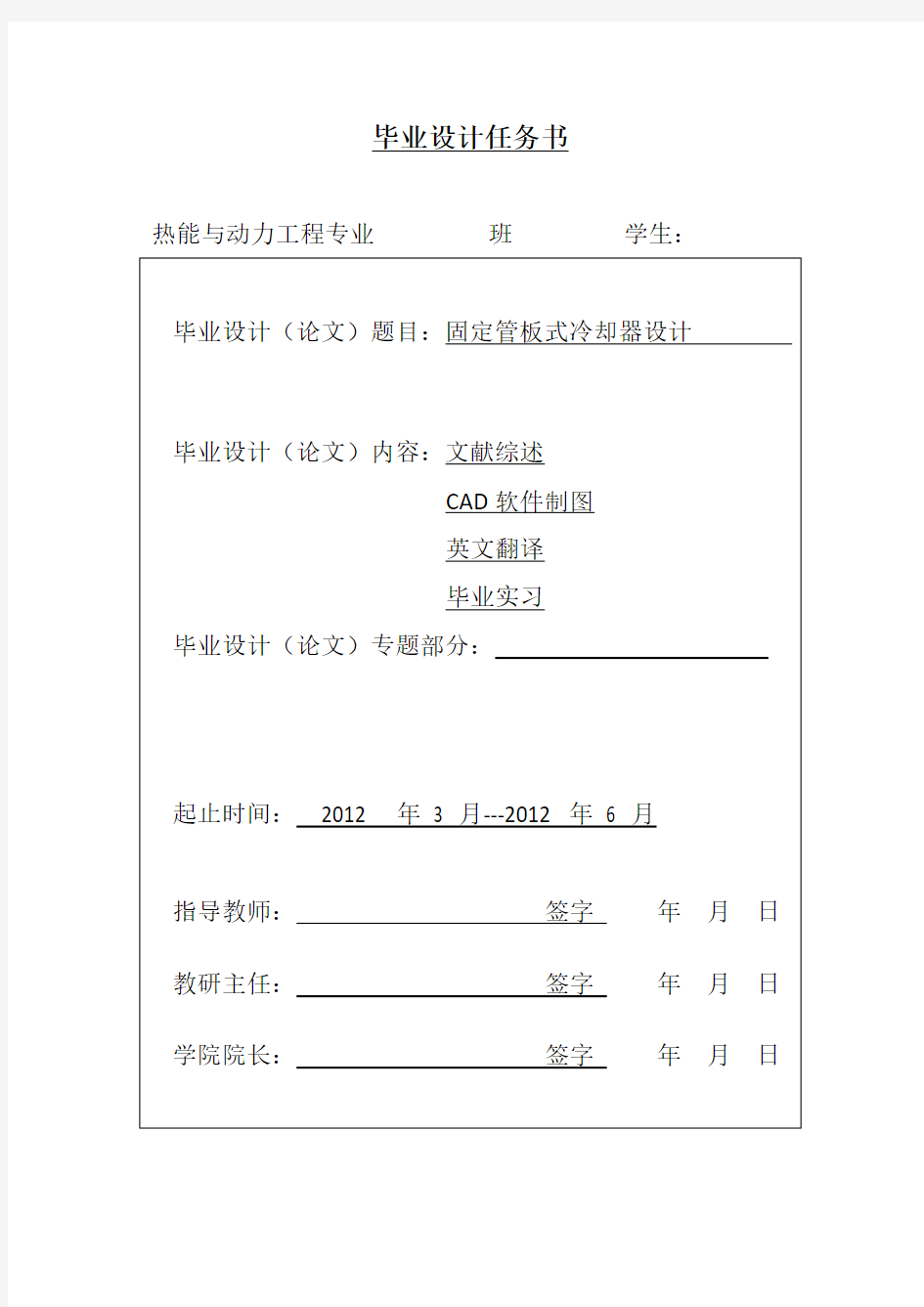

沈阳化工大学本科毕业设计
题目:固定管板式换热器设计
院系:能源与动力工程学院
专业:热能与动力工程
毕业设计任务书
热能与动力工程专业班学生:
毕业设计(论文)题目:固定管板式冷却器设计
毕业设计(论文)内容:文献综述
CAD软件制图
英文翻译
毕业实习
毕业设计(论文)专题部分:
起止时间:2012 年 3 月---2012 年 6 月
指导教师:签字年月日教研主任:签字年月日学院院长:签字年月日
毕业设计开题报告
论文题目: 固定管板式换热器的设计
学生姓名:
专业班级: 学号:
指导教师:
2013年3月1日
1.选题的目的和意义
换热器为石油化工、食品、原子能及其它化工部门所广泛使用的一种工艺设备。一般情况换热器约占石油化工装置设备总重量的40%。
近年来,随着制造技术的进步,强化转热元件的开发,使得新型高效换热研究有了较大的发展,根据不同的工艺条件与换热工况制造了不同结构形式的新型换热器,并已在化工、炼油、石油化工、制冷和制药各行业得到应用与推广,取得了较大的经济效益。
2.题目要完成的主要内容和预期目标
本次设计的换热器是固定管板式换热器,主要完成冷却水一煤油间的热量交换。管程工作压力为0.25Mpa,壳程工作压力为0.2Mpa。设计温度壳程是75℃,管程为35℃。管程内介质是自来水,壳程内为煤油。选用石棉作保温材料,厚度为100mm。
根据任务书中流体进、出口的温度计算传热负荷,确定,选定换热器形式,选取换热器的材料,确定主要结构尺寸,满足强度、刚度和稳定性等要求,根据设计压力确定壁厚,使换热器有足够的腐蚀裕度。
结构设计的一般顺序为:
1.管箱设计,选择管箱短节、分程隔板、的材料尺寸及管箱深度。
2.圆筒设计,选择合适的材料,计算结构尺寸。
3.封头设计,选择封头形式,分别计算所受内压和外压。
4.管板设计,确定连接形式,计算最小厚度。
5.拉杆和定管距,确定拉杆的结构形式、直径和数量、布置及定管距结构尺寸。
6.折流板设计,选择折流板形式、尺寸及板间距。
7.容器法兰及支座的选取。
8.强度校核,对上述步骤确定的结构尺寸形式进行强度校核,如不满足要求需重新进行结构设计、再校核,直至符合要求。
最后通过设计计算提高换热器的传热效率和减少能源消耗,达到更高效,更节能的目的。
3.进度计划
1.查阅中外文期刊文献、整理成文献综述、翻译一篇英文资料、写出开题报告。时间:第1周一第4周
2.进行换热器传热计算、设计计算和强度校核,用Auto CAD对换热器本体图及主要零部件图进行初步绘制。时间:第5周一第7周
3. 确定结构、正式计算。(5月4日—5月6日中期检查)时间:第8周一第11周
4.完善设计说明书,初步进行结构设计,为出图做准备。时间:第12周一第14周
5. 计算说明书及图纸全部整理完毕,将电子版上交给指导教师。进一步修改图纸,准备答辩。时间:第15周一第16周
6.做答辩准备。时间:第17周一第18周
4.论文提纲
一、文献综述
二、传热工艺计算
三、强度计算
参考文献
致谢
附录一英文文献及翻译
附录二实习报告
指导教师意见
指导教师签字:
年月日
内容摘要
换热器是进行热交换操作的通用工艺设备,被广泛应用于各个工业部门,尤其在石油、化工生产中应用更为广泛。以炼油厂为例,换热器占设备总金属消耗量的20%左右。它既是工艺流程中的重要装备,同时又是企业减少能源消耗、降低生产成本的主要手段。由于世界性的能源危机,为了降低能耗,工业生产中对换热器的需求量越来越多,对换热器的质量要求也越来越高。换热器分类方式多样,按照其工作原理可分为:直接接触式换热器、蓄能式换热器和间壁式换热器三大类,其中间壁式换热器用量最大,据统计,这类换热器占总用量的99%。间壁式换热器又可分为管壳式和板壳式换热器两类,其中管壳式换热器在长期的操作过程中积累了丰富的经验,其设计资料比较齐全,在许多国家都有了系列化标准,工业生产中有高度的可靠性并具有广泛的适应性
本课题设计一个固定管板式换热器,相对于其他几种换热器,它具有以下优点:结构简单,加工方便,造价低;在相同壳体直径内排管最多,结构紧凑,可以使用各种材质的换热管;处理介质包括有相变和无相变各种介质的换热过程。根据GB151-1999《管壳式换热器》、GB150-1998《钢制压力容器》进行设计,主要包括以下四个部分:文献综述、传热工艺计算、强度校核错误!未找到引用源。CAD制图。
第一,文献综述:查阅与课题相关中外期刊,编写文献综述。第
二,传热工艺计算:根据所给数据查的相关物性参数并计算有效平均温差;由Dittus-Boetler公式计算管程换热系数;同理,有相关公式计算壳程换热系数并初定换热器结构;再计算总传热系数;根据相关公式计算管程压降与壳程压降并进行校核。第三,强度校核:选择换热器材料、规格,排列方式;确定筒体壁厚、管箱短节壁厚与管程封头壁厚并进行应力校核与液压实验;选择设备法兰与接管法兰;设计管板的厚度并对危险工况下的管板应力、壳程法兰应力、管子应力、壳程圆筒轴向应力、拉脱力进行校核;拉杆与定距管的确定;折流板、防冲板、分程隔板的选择;接管的选择与是否需开口补强的确定;鞍座的选择及应力校核。第四,运用AutoCAD软件进行绘图设计,图纸包括装配图和拉杆、左右管板、左右管箱等零件图。
换热器既可以是一种单独的设备,也可是某一工艺设备的组成部分。它的主要功能是保证工艺过程对介质所要求的特定温度,同时也是提高能源利用率的主要设备之一。通过这次设计使我更深入的了解了影响传热过程的各种因素,并通过改变它们使之符合设计要求。同时,也因CAD作图中所遇的各种困难与错误,并在逐步的克服与改正过程中知道换热器某一部分的具体构造以及为什麽这样。
关键字:换热器;换热管;固定管板
Abstract
Heat exchanger for heat exchange operation is a common sectors, especially in the petroleum, chemical production more widely used .In the refinery, for example, the total heat consumption of metal equipment accounted for about 20%. It is an important process equipment , is also the companies to reduce energy consumption, the primary means of reducing production costs. As a worldwide energy crisis, in order to reduce energy consumption, industrial production, the demand for more and more heat exchanger, the heat exchanger quality requirements are also increasing.Heat exchanger classification diverse, according to its working principle can be divided into: direct -contact heat exchangers, heat exchanger accumulator and recuperative heat exchanger three categories, including the largest amount of recuperative heat exchanger , according to statistics, such heat exchanger 99% of the total amount .Recuperative heat exchanger can be divided into a shell and tube and shell heat exchanger types, including shell and tube heat exchanger in the long-term operation has accumulated rich experience in the design data more complete, in many countries have a standard series, industrial production has high reliability and wide range of adaptability.
Design of this project a fixed tube heat exchanger, heat exchanger relative to other types , it has the following advantages: simple structure,
easy processing, low cost, within the same shell diameter discharge pipe up, compact structure, you can use the kind of material tubes, treatment media including phase transition and no phase change heat transfer process a variety of media. According to GB151-1999 ‘shell and tube heat exchangers’, GB150-1998 ‘Steel Pressure Vessels’ for design, including the following four sections: literature review, heat transfer process calculation, strength check CAD drawings.
First, the literature review : Review and issues related to foreign journals, writing literature review .Second, the heat transfer process calculation : According to the data related to the investigation and calculation of effective physical parameters of mean temperature difference, Calculated by the Dittus-Boetler tube heat transfer coefficient, Similarly, relevant formula shell heat exchanger heat transfer coefficient and an initial structure; then calculate the overall heat transfer coefficient; calculated according to the relevant tube and shell side pressure drop pressure drop and be checked. Third, the strength check : Select exchanger materials, specifications and arrangement, determine the cylinder wall thickness, tube box with a short section of wall thickness of the tube head and conduct stress check with the hydraulic test, selection device flange and take over the flange, design tube plate thickness and dangerous conditions of the tube sheet stress, stress shell flanges, pipe stress, axial stress cylindrical shell, pull-off force to be checked, Tie with
fixed pitch pipe to determine, baffles, anti-red plates, partition plates choice, takeover selection and the need to determine the opening reinforcement, saddle selection and stress check. Fourth, the use of AutoCAD software for graphic design, drawings, including assembly drawings and rod, so the tube plate, left tube boxes and other parts diagram .
Heat exchanger can be either a stand-alone device, but also a part of the process equipment. Its main function is to ensure that the process media required for the particular temperature, but also improve the energy efficiency of the main equipment. Through this design makes me a better understanding of the various factors that influence the heat transfer process, and by changing them to conform to the design requirements. At the same time, also because of CAD drawing in the various difficulties encountered with errors and corrections in the gradual process of overcoming and a portion of the heat exchanger to know the specific structure and why.
Keywords : Heat exchanger ; Tubes ; Fixed tube plate
目录
引言 (1)
第一章绪论................................................. 错误!未定义书签。
1.1 研究的目的和意义 (2)
1.2 国内外发展状况 (3)
1.3 发展方向 (7)
第二章传热工艺计算 (8)
2.1原始数据 (8)
2.2 定性温度及物性参数 (8)
2.3传热量与柴油的出口温度及柴油的定性温度 (9)
2.4有效平均温度 (9)
2.5管程换热系数计算 (10)
2.6结构的初步设计 (11)
2.7壳程换热系数计算 (11)
2.8传热系数计算 (12)
2.9管壁温度计算 (13)
2.10管程压降计算 (13)
2.11壳程压降计算 (14)
第三章强度计算 (15)
3.1换热管材料及规格的选择和根数确定 (15)
3.2管子的排列方式 (15)
3.3确定筒体直径 (16)
3.4筒体壁厚的确定 (16)
3.5液压试验 (18)
3.6封头厚度的计算 (18)
3.7法兰的选择 (20)
3.7.1 设备法兰的选择 (20)
3.7.2 接管法兰的选择 (20)
3.8、管板的设计 (21)
3.9. 折流板的选择 (37)
3.9.1 选型 (37)
3.9.2 折流板尺寸 (37)
3.9.3 换热管无支撑跨距或折流板间距 (37)
3.9.4 折流板厚度 (37)
3.9.5 折流板直径 (37)
3.10 管箱短节壁厚的计算 (38)
3.11 拉杆和定距管的确定 (38)
3.12 分程隔板厚度选取 (39)
3.13 支座的选择及应力校核 (39)
3.13.1 支座的选择 (39)
3.13.2 鞍座的应力校核 (40)
参考文献 (43)
附录一英文文献原文 (45)
附录二英文文献翻译 (61)
引言
换热器设备是化学工业错误!未找到引用源。石油工业、石油化工等生产中最重要的设备之一,为了帮助我们的复习与巩固以往学习过的专业知识,并对换热器设备有一个深入了解。
毕业设计是我们在学校结束阶段的一个综合学习、训练,培养独立工作能力的重要教学环节,毕业设计作为一个独立的教学环节,不同于一门课程的学习,又不同于实际工程设计工作。
毕业设计是一项学习任务,又是一项独立的创造性工作。最大限度的采用新技术成就,反映现代技术的发展水平,充分发挥独立工作能力,一定要遵循理论联系实践的原则。
由于知识贫乏与经验不足,这次设计中不可避免的会有错漏之处,敬请老师们给予谅解。
第一章绪论
1 研究的目的和意义
随着现代工业的发展,以能源为中心的环境、生态等问题日益加剧。世界各国在寻找新能源的同时,也更加注重了节能新途径的研发。强化传热技术的应用不但能节约能源、保护环境,而且能大大节约投资成本。换热器由于其在化工、石油、动力和原子能等工业部门的广泛应用,使得换热器的强化传热技术一直以来受到研究人员的重视,各种研究成果不断涌现[1]。
换热器是一种实现物料之间热量传递的节能设备,在石油、化工、冶金、电力、轻工、食品等行业应用普遍。在炼油、化工装置中换热器占总设备数量的40%左右,占总投资的30%一45%。近年来随着节能技术的发展,换热器的应用领域不断扩大,带来了
显著的经济效益[2]。
目前,在换热设备中,管壳式换热器使用量最大。因此对其进行研究就具有很大的意义。
换热器换热过程是为了实现下列目的:⑴通过减小设计传热面积来减小换热器的体积和质量⑵.提高已有换热器的换热能力⑶.使换热器能在较低额温差下正常工作⑷.通过减小换热器的流体阻力来减少换热器的动力消耗